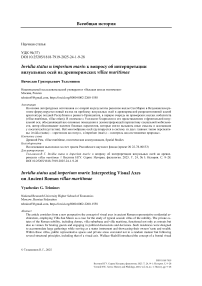Invidia status и imperium maris: к вопросу об интерпретации визуальных осей на древнеримских villae maritimae
Автор: Тельминов В.Г.
Журнал: Вестник Новосибирского государственного университета. Серия: История, филология @historyphilology
Рубрика: Всеобщая история
Статья в выпуске: 1 т.24, 2025 года.
Бесплатный доступ
На основе литературных источников и с опорой на результаты раскопок виллы Сан Марко в Везувианском регионе формулируется новый взгляд на проблему визуальных осей в древнеримской репрезентативной жилой архитектуре поздней Республики и раннего Принципата, в первую очередь на приморских виллах нобилитета (villae maritimae, villae otium). В полемике с Уоллесом-Хэдриллом и его представлением о фронтальной визуальной оси, объединяющей все основные помещения и демонстрирующей перспективу социальной мобильности, автор обосновывает наличие боковых перспектив, которые могли вызывать иные смыслы и ассоциации у посетителей (суггестии). Всё многообразие осей группируется в систему из двух главных типов перспективы: invidia (status) - «претензия на статус», и imperium (maris) - «контроль над состояниями природы».
Древний рим, villae maritimae, политическая коммуникация, spatial studies
Короткий адрес: https://sciup.org/147247136
IDR: 147247136 | УДК: 94(37) | DOI: 10.25205/1818-7919-2025-24-1-9-28
Список литературы Invidia status и imperium maris: к вопросу об интерпретации визуальных осей на древнеримских villae maritimae
- Хоуи Т. Н. Прогулки с властью: движение и виды на виллах римской элиты в Стабиях // Шаги / Steps. 2017. Т. 3, № 4. С. 234-250.
- Astin A. E., Frederiksen M. W., Ogilvie R. M. The Cambridge Ancient History. Rome and the Mediterranean to 133 BC. 2nd ed. Cambridge: Cambridge Uni. Press, 2008. 650 p.
- Castex J. Architecture of Italy. Westport: Greenwood Press, 2008. 230 p.
- Clarke J. R. The Houses of Roman Italy, 100 B.C. - A.D. 250: Ritual, Space, and Decoration. Los Angeles: Uni. of California Press, 1991. 448 p.
- D’Arms J. H. Romans on the Bay of Naples: A Social and Cultural Study of the Villas and Their Owners from 150 B.C. to A.D. 400. Cambridge: Harvard Uni. Press, 1970. 296 p.
- D’Arms J. H. Puteoli in the Second Century of the Roman Empire: A Social and Economic Study // The Journal of Roman Studies. 1974. Vol. 64. P. 104-124.
- Drerup H. Architektur als Symbol. Zur zeitgenössischen Bewertung der römischen Architektur // Gymnasium. Zeitschrift für Kultur der Antike und humanistische Bildung. 1966. Bd. 73, Ht. 1/2. S. 181-196.
- Gardelli P. Stabiae and the Beginning of European Archaeology: from Looting to Science // Actual Problems of Theory and History of Art. 2016. Vol. 7. P. 681-690.
- Habenstein A. Abwesenheit von Rom: aristokratische Interaktion in der späten römischen Republik und in der frühen Kaiserzeit. Heidelberg: Heidelberg Uni. Press, 2015. 361 p.
- Howe T. The Social Status of the Villas of Stabiae // The Roman Villa in the Mediterranean Basin. Cambridge, 2018. P. 97-119.
- Klein M. Envy and Gratitude. A Study of Unconscious Sources. 1946-1963. London; Toronto: Tavistock Publ., 1957. 99 p.
- Kohn M. Brave New Neighborhoods: The Privatization of Public Space. New York: Routledge, 2004. 244 p.
- Konstan D. The Consept of “Emotion” from Plato to Cicero // Methexis. 2006. Vol. 19. P. 139-151.
- Lomas K. The Weakest Link: Elite Social Networks in Republican Italy History and Archaeology of Classical Antiquity // Roselaar S. T. Processes of Integration and Identity Formation in the Roman Republic. Leiden; Boston, 2012. P. 197-215.
- Lundgreen C. Lucullus und die politische Kultur der römischen Republik. Konkurrenz und Distinktion zwischen Feldherren, Feinschmeckern und Fischteichbesitzern // Hölkeskamp K.-J., Beck H. Verlierer und Aussteiger in der “Konkurrenz unter Anwesenden”. Agonalität in der politischen Kultur des antiken Rom. Stuttgart, 2019. S. 81-126.
- Marzano A. Roman Villas in Central Italy: a Social and Economic History. Leiden; Boston: Brill, 2007. 823 p.
- Marzano A., Métraux G. P. R. The Roman Villa in the Mediterranean Basin: Late Republic to Late Antiquity. Cambridge: Cambridge Uni. Press, 2018. 650 p.
- Mayer J. W. Imus ad villam: Studien zur Villeggiatur im stadtrömischen Suburbium in der späten Republik und frühen Kaiserzeit. Stuttgart: Franz Steiner Verlag, 2005. 266 S.
- Platts H. Multisensory Living in Ancient Rome: Power and Space in Roman Houses. New York: Bloomsbury Publ., 2019. 361 p.
- Sanders E. Envy and Jealousy in Classical Athens: a Socio-Psychological Approach. Oxford: Oxford Uni. Press, 2014. 207 p.
- Smith J. Roman Villas: A Study in Social Structure. London: Routledge, 1998. 378 p.
- Wallace-Hadrill A. The Social Structure of the Roman House // Papers of the British School at Rome. 1988. Vol. 56. P. 43-97.
- Wallace-Hadrill A. Rethinking the Roman Atrium House // Laurence R., Wallace-Hadrill A. Domestic Space in the Roman World: Pompeii and Beyond. Portsmouth, 1997. P. 219-240.
- Wallace-Hadrill A. Houses and Society in Pompeii and Herculaneum. Princeton: Princeton Uni. Press, 2022. 276 p.
- Weeber K.-W. Die Schwelgerei, das süsse Gift: Luxus im alten Rom. Darmstadt: Primus, 2003. 184 S.


